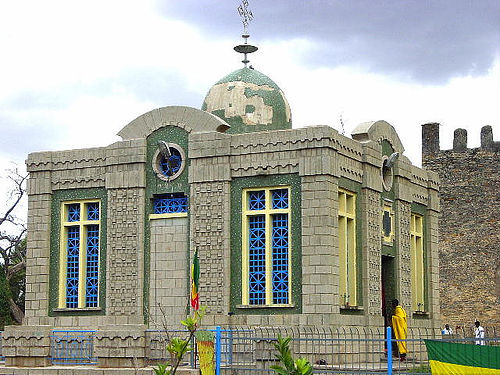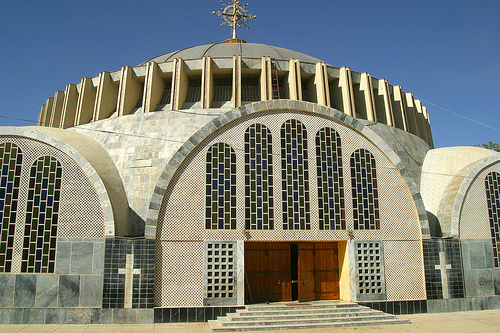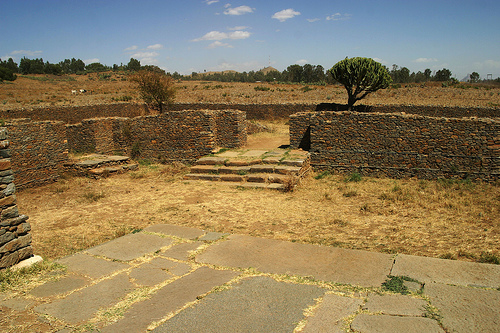

Location: Tigray Province
 Axum
is a major city in the Northern Ethiopia and a former capital of the
Aksum Kingdom. Ethiopians believe that Chapel of the Tablet in Axum
is a last resting place of the Ark of the Covenant. It is believed
that protection of this religious artifact allowed Ethiopia to stay
independent from colonization by the outsiders. Regardless whether
it is true or not, one thing is for certain: it was the only country
on the continent that remained free from conquest. Chapel of the
Tablet is believed to be the final resting place of the Ark of the
Covenant. After the Babylonians captured Jerusalem the ark
disappered. The Bible left no traces of what actually happened to
this religious artifact. However Ethiopians believe that the ark was
brought to Ethiopia to a small monastery on the lake Tana. Ethiopian
kings believed they were descendents of king Solomon and Queen Sheba
(First Kings 10-13), so it made sense why the Ark with tablets of
Moses were brought to Ethiopia. In the ancient times Ethiopian kings
were crowned here.
Axum
is a major city in the Northern Ethiopia and a former capital of the
Aksum Kingdom. Ethiopians believe that Chapel of the Tablet in Axum
is a last resting place of the Ark of the Covenant. It is believed
that protection of this religious artifact allowed Ethiopia to stay
independent from colonization by the outsiders. Regardless whether
it is true or not, one thing is for certain: it was the only country
on the continent that remained free from conquest. Chapel of the
Tablet is believed to be the final resting place of the Ark of the
Covenant. After the Babylonians captured Jerusalem the ark
disappered. The Bible left no traces of what actually happened to
this religious artifact. However Ethiopians believe that the ark was
brought to Ethiopia to a small monastery on the lake Tana. Ethiopian
kings believed they were descendents of king Solomon and Queen Sheba
(First Kings 10-13), so it made sense why the Ark with tablets of
Moses were brought to Ethiopia. In the ancient times Ethiopian kings
were crowned here.
Unfortunately no one is allowed to see
the ark itself and even gaze at it. There are no exceptions to this
rule. Only one man is allowed inside the chapel. He takes care of
the ark, but in return he can not leave the premises of the church.
He also has to keep a strict fast for the rest of his life. It seems
that the chapel has no security, but in fact many of the people that
are commonly seen around fence stand guard all the time. If you try
to approach the entrance to the chapel you will immediately realize
that all these resting people get from the ground and approach you.
Particularly impressive is celebration of Timket Festival (Ethiopian
version of Epiphany) that is held on January 7 when many pilgrims
and priests held a service at night surround by torches. Another
important holiday is celebrated on November 24 that is known as
Festival of Maryam (Mary) Zion.

One of the most impressive achievement of kingdom of Aksum was construction of several obelisks. This tradition was probably influenced by the Egyptians that lived to the North.
Ezana stone is a documented historic account about life of Ethiopian king Ezana. He ruled between 330 AD and 356 AD over kingdom of Aksum and greatly increased its size by conquest of many neighboring nations and tribes including Merow, Nubia, kingdom of Kush and many others. He also is famous as a first ruled in the history of the country to convert to Christianity along with his nation. As with Rosetta stone in Egypt, Ezana Stone is written in several languages. This include Greek, Ge'ez (ancient Ethiopian) and Sabaean (South Arabian).

This large reservoir was actually designed to hold water rather than serve as a bath for the royalty. In the ancient times it was part of the massive palace complex that covered an area of 3250 square meters. It is known locally as a Dungur or Dungu Addi Kilte. The legend claims that it was erected by the orders of Queen of Sheba. In the Old Testament of the Bible it is claimed that she travelled to Jerusalem to met king Solomon, who became famous for his wisdom. She met him and upon return to Ethiopia she gave birth to their son.